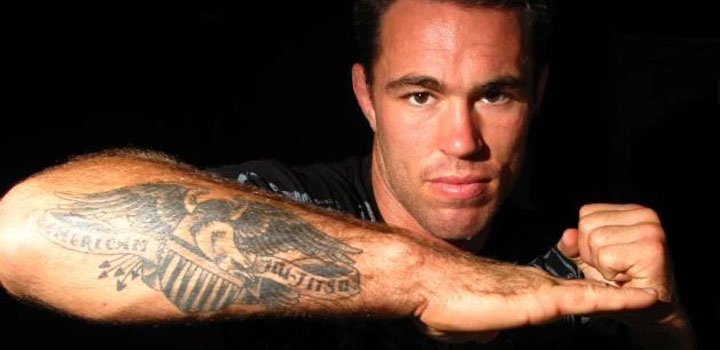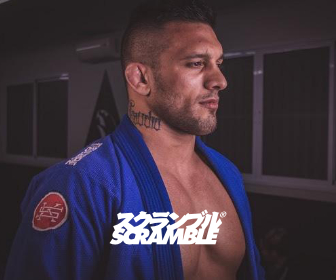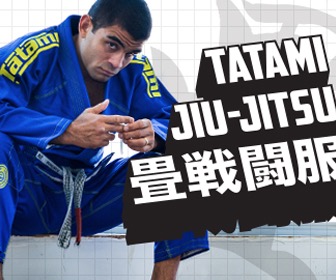Over the past few weeks, it seems near impossible to escape the “American Jiu-Jitsu” debate. The tag-line isn’t new, from seeing it tattooed across Jake Shields‘ forearm for over a decade to having books published at least 70 years ago on that same subject.

Shields AJJ Tattoo
The current rebirth of the topic and stream of heated debates that followed came after Flograppling released their documentary on the matter, a film which – for full disclosure – we have not seen yet. Nevertheless, the spokesperson – or at the very least the most vociferous voice – for this American Jiu-Jitsu uprise has been Keenan Cornelius, the founder of the Legion Academy and one of the most charismatic and well-known figures in our sport.
In a recent post on his social media account (see below), Keenan explained his own definition of the phrase, saying it signifies “Americans who do jiu-jitsu“. Simple enough. He also added there is no perfect definition for the expression as it is still open for interpretation.
View this post on Instagram
To address this is a contentious topic we first must assess what are the differences between the designations: Brazilian Jiu-Jitsu and American Jiu-Jitsu. We will address that below.
WHAT IS BRAZILIAN JIU-JITSU?
Jiu-Jitsu by itself is an ancient martial art whose roots trace back to Japan, having since spawned several different martial arts, combat styles, and systems, one of those “evolutions” taking place in Brazil, known by many as BJJ. An interesting side of the “BJJ” terminology is that no one calls it Brazilian Jiu-Jitsu in Brazil, there it is simply known as “jiu-jitsu”.
The “Brazilian” was added once the grappling style was exported to the United States when there was a need to differentiate it from the more traditional jiu-jitsu schools already existing in the Northern Hemisphere. Those are now named “Japanese Jiu-Jitsu”, “Traditional Jiu-Jitsu”, or simply Ju-Jutsu schools (without the “i”).
There is a clear distinction between the programs developed by “BJJ” schools and “TJJ” schools. As different as, for example, judo is from wrestling – where technically some positions overlap, but the contrasting rules and objectives of the game deem them very different sports, even to the untrained eye.
The crux of Brazilian jiu-jitsu lies in its groundbreaking rule-set. Its positional grappling hierarchy – point system – based on the rules of a “real” physical altercation changed the course of combat sports. The rules first set-up by the Gracie Family jointly with few other revered coaches from the Rio de Janeiro area during the late 1960s and have been continuously updated over the years to accommodate new positions and trends. The first draft of this point system was set by the Jiu-Jitsu Federation of Guanabara (Federação de Jiu-Jitsu da Guanabara).
One of the great developers of the Brazilian Jiu-Jitsu ruleset and its expansion overseas was the Confederação Brasileira de Jiu-Jitsu (CBJJ), which started in the mid-1990s by way of Carlos Gracie Junior as an evolution of his uncle’s FJJG. It has since grown into the famous International Brazilian Jiu-Jitsu Federation (IBJJF).
Following the meaning of the original federation’s name (CBJJ) it simply translated to a “federation of jiu-jitsu from the country of Brazil”, and not BJJ Federation, nevertheless, it was certainly easier, for marketing purposes, to assert it as BJJ and differentiate our sport from the traditional martial art (TJJ).
So, in short, BJJ is a sport. It has a set of rules, a federation, and a large following of schools who develop programs around this ruleset and compete against each other.
WHAT IS AMERICAN JIU-JITSU?
As aforementioned, there is no clear definition for this expression. Some attribute the American style of jiu-jitsu to a more cross-training minded approach as so many American athletes originally came from a high-school/collegiate wrestling background. There certainly seems to be some ground for that idea, although cross-training was also common in Brazil, particularly during the early days of the sport.
Many of jiu-jitsu’s 1990s and 2000s Brazilian stars cross-trained, from Ricardo Arona and Leo Vieira‘s wrestling training to Royler Gracie, Mário Sperry, Ricardo Libório, Amauri Bitetti‘s judo prowess, to name just a few.
In fact, cross-training is as ancient as the closed guard, a position that arrived in BJJ by way of judoka Osvaldo Alves‘s (more on that here). There are also numerous accounts of Rolls Gracie‘s training methodology being heavily reliant on his freestyle wrestling and sambo experiences during the 1970s. Cross-training isn’t new, yet, there are many solid US grapplers today who came from a wrestling background.
Another issue with classing American jiu-jitsu as a more wrestling-centric style would be that of outstanding guard players from the US, such as Mikey Musumeci, Isaac Doederlein, Keenan Cornelius, Gordon Ryan, and so many more. Would those names be labeled outside the AJJ category? We would disagree with that notion, considering they are among the country’s most successful athletes.
CONCLUSION
Although hard to pinpoint what AJJ truly stands for, the influence Americans have had in jiu-jitsu over the past decade is immeasurable. From Cornelius’ lapel guard innovations to Musumeci’s crab ride breakthroughs, and – of course – Danaher Death Squad’s groundbreaking advancements in the leg-lock department. America is where the sport has fed for fresh ideas as of late.
Currently, the biggest case to be made for the American Jiu-Jitsu terminology as a grappling style, in our opinion, is that of the leg-lock game. Definitely, an area of our sport where the US squad has taken the lead and is likely to keep it for a while.
Leg-lock game or lapel game, these are, as the word says: “games”. As we stand, this is likely the biggest difference between Brazilian Jiu-Jitsu and American Jiu-Jitsu. BJJ is a sport, a ruleset for which countless jiu-jitsu school programs work towards. You will have BJJ athletes competing in submission-only, of course, but their schools and technical systems have been catered for BJJ.
The meaning of AJJ is still very much up for discussion. It is not a sport, it is not a specific grappling program, nor is it a particular system, but it certainly appears to be a movement in the making.
An interesting topic and one we are sure will not end here, expect the BJJ Vs AJJ to keep burning up on social media. But whatever your stand is on the matter, remember, the most important thing is to keep training.





 (@keenancornelius)
(@keenancornelius)










Great points about AJJ & BJJ! Also the Battle Tested Pressure Passing by Bernardo Faria is incredible. Loved the content.